What Column Failures Teach Us About the Biomechanics of Posture
- Updated - November 10, 2025
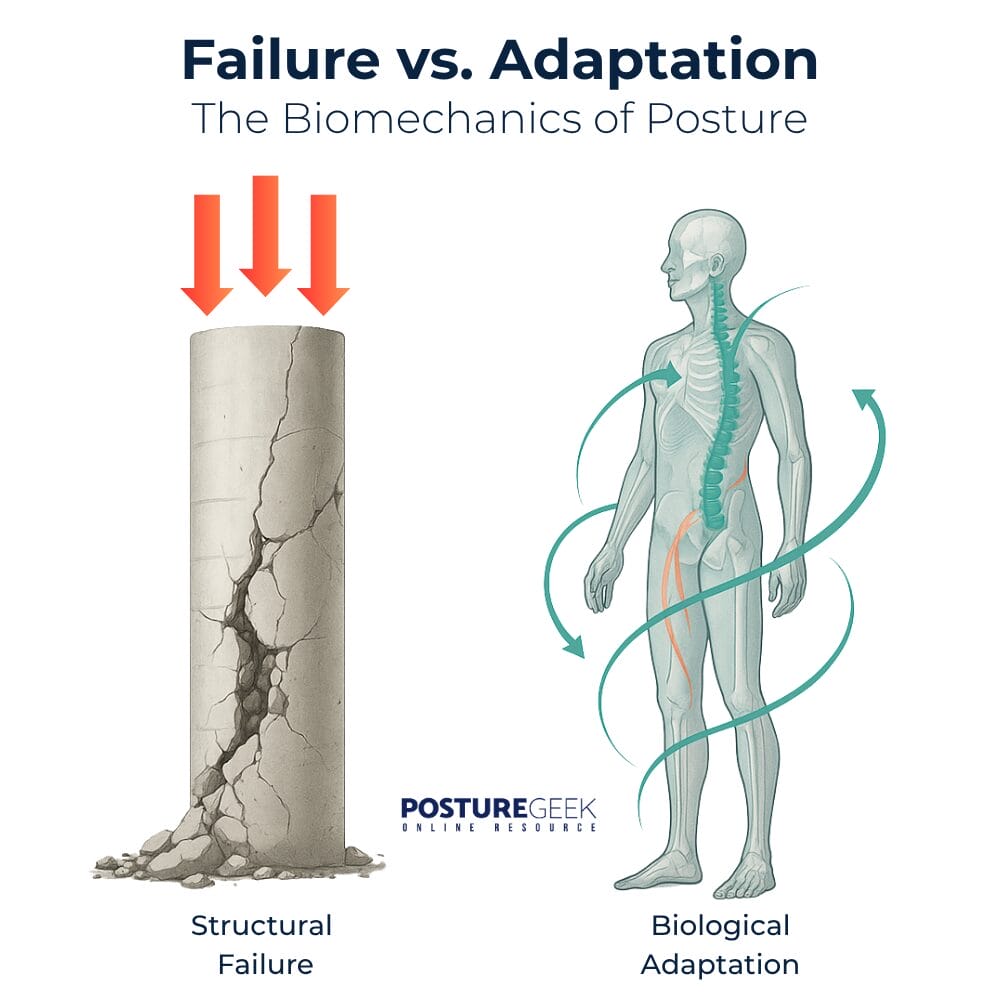
A column, a bridge, or a human spine all follow the same rules of physics. Each resists gravity, bears load, and eventually reaches its limit, revealing the shared principles behind engineering and the biomechanics of posture. When a concrete column buckles, its failure echoes the same forces that shape how we stand, move, and adapt.
The human body is an architectural marvel. Beneath the skin lies an intricate framework of bones, muscles, and connective tissue that mirrors the logic of engineering design. We rely on this structure to carry us through gravity, impact, and time. The difference is that our columns breathe, repair, and learn. Yet the principles of failure remain the same.
Understanding these patterns is the heart of the biomechanics of posture. It reveals how the body endures load, how it begins to fail, and how it can recover strength through adaptation and postural biomechanics.
The Three Failure Modes of Columns and Humans
In structural engineering, columns usually fail in one of three ways: buckling, compression, or shear. These forms of failure have clear parallels in human posture and movement. Recognizing them can change how we interpret everything from pain to performance.
Buckling and the Biomechanics of Postural Collapse
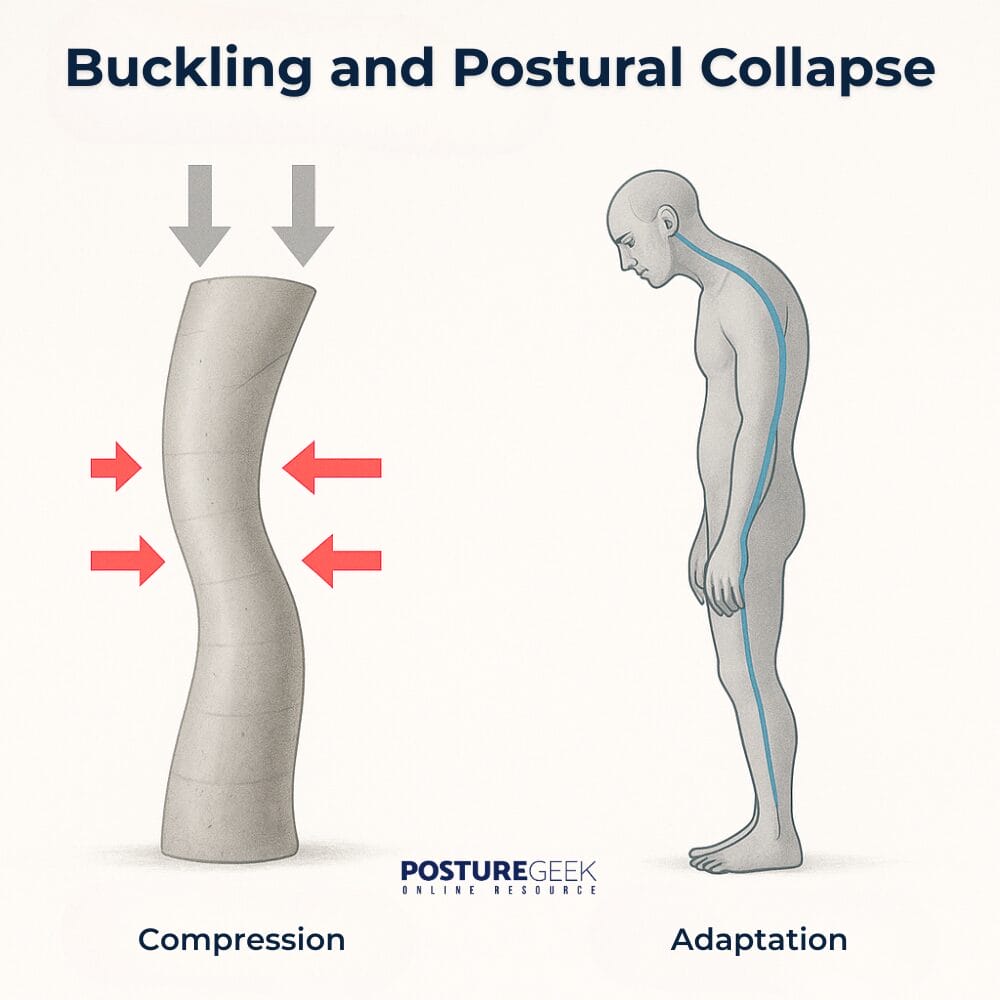
In Engineering
A slender column can bear tremendous weight until the load becomes uneven. Once that happens, one side compresses while the other stretches. The column bows, loses stability, and begins to deform. This same phenomenon appears in the biomechanics of posture, where uneven tension and poor load distribution alter spinal mechanics. This is buckling. It is rarely sudden; it is the visible sign of imbalance that has built up over time.
Discover a practitioner near you.
Looking for a practitioner near you? Our extensive network of qualified professionals is here to help you.
In the Human Body
When someone’s posture begins to sag or curve, we’re watching a living form of buckling. Hours spent sitting, leaning into one hip, or carrying the head forward all shift the body’s natural line of load.
Forces that should travel evenly through the spine and fascia begin to collect unevenly. At first, the body adjusts, tightening one side, lengthening the other to stay balanced. But small corrections repeated over time become new habits.
Tension builds, stability fades, and the spine drifts from alignment into adaptation. Over time, the pattern of buckling reflects deeper distortions in structural alignment and movement mechanics.
The Living Difference
Concrete fails completely once its threshold is reached. The human body does not. Muscles, fascia, and deep stabilizers act as living reinforcement, continuously making small adjustments to keep us upright. Each breath, each shift of weight, is a quiet act of correction. Yet repetition and fatigue slowly dull that capacity.
When variation disappears and strain becomes constant, the body adapts to survive rather than to thrive. It doesn’t collapse, it recalibrates, settling into a less efficient version of support that still holds us together. A living example of how the biomechanics of posture evolve through adaptation.
Compression and How the Body Bears Load
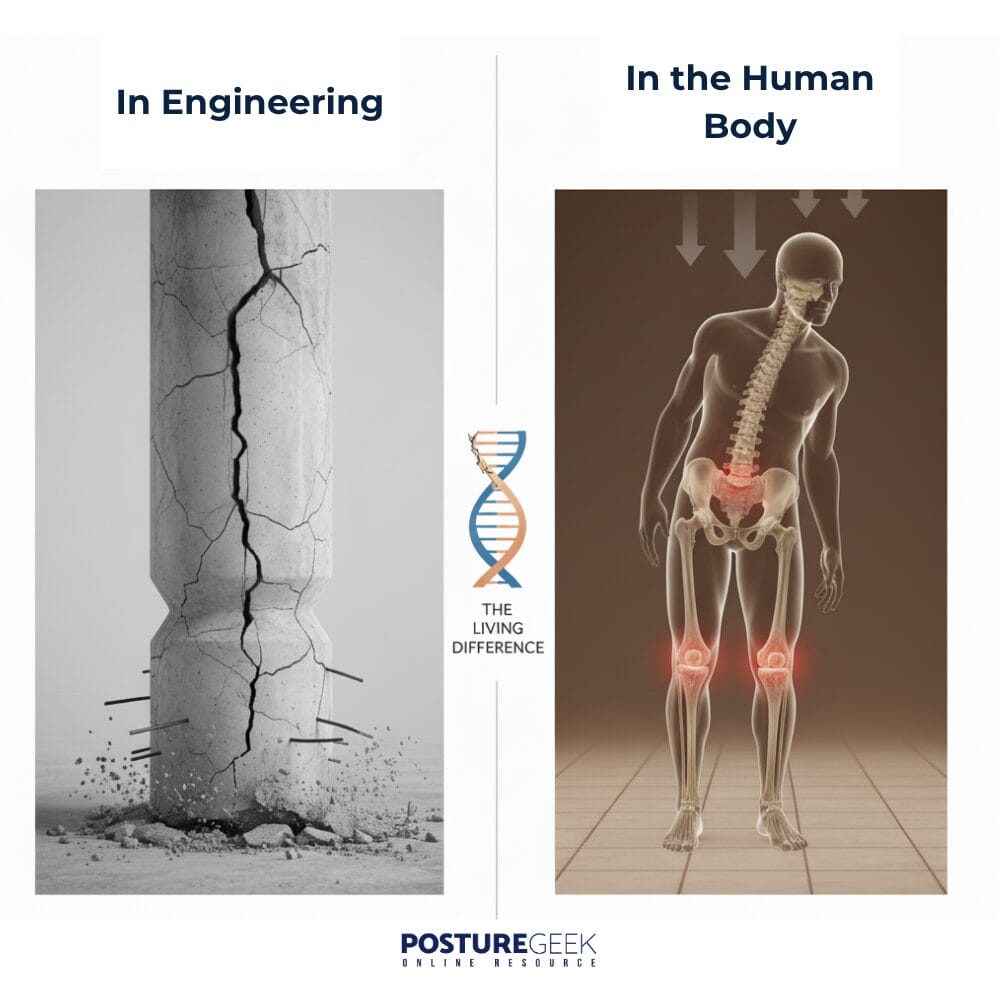
In Engineering
Compression failure occurs when a column is crushed by excessive vertical force. The material shortens, cracks begin to form, and its internal structure loses strength. The failure often starts at the base where the load is greatest. This is the point of least mobility and the highest stress concentration. Once the internal bonds can no longer distribute force evenly, the structure gives way.
In the Human Body
The same physics apply, but the process unfolds more gradually. The spine, hips, and knees carry vertical load through every step, lift, and standing posture. Too much sitting, repetitive impact, or poor lifting technique slowly changes how that load is managed. Discs thin, joints stiffen, and supportive muscles fatigue.
The body does not fail in an instant; it compresses over time, millimeter by millimeter, until mobility and resilience begin to fade. The warning signs are subtle at first, such as stiffness on waking, knee pain after long periods of standing, or a back that feels tired before the day is done. Each of these small sensations signals that the system is yielding under imbalance.
The Living Difference
Moderate compression is essential. The body depends on it. Load is the stimulus that keeps tissues alive and responsive. Walking, strength training, and varied movement stimulate bone density, reinforce connective tissue, and maintain the fascia’s elastic tension. This reflects Wolff’s Law, which describes how bone and soft tissue remodel in response to mechanical stress.
The key is balance. When compression is uneven, excessive, or unrelieved, the process of adaptation shifts toward breakdown. The same forces that once maintained strength begin to wear the body down, not because the laws of physics change, but because the pattern of use does.
Shear Forces and Postural Instability
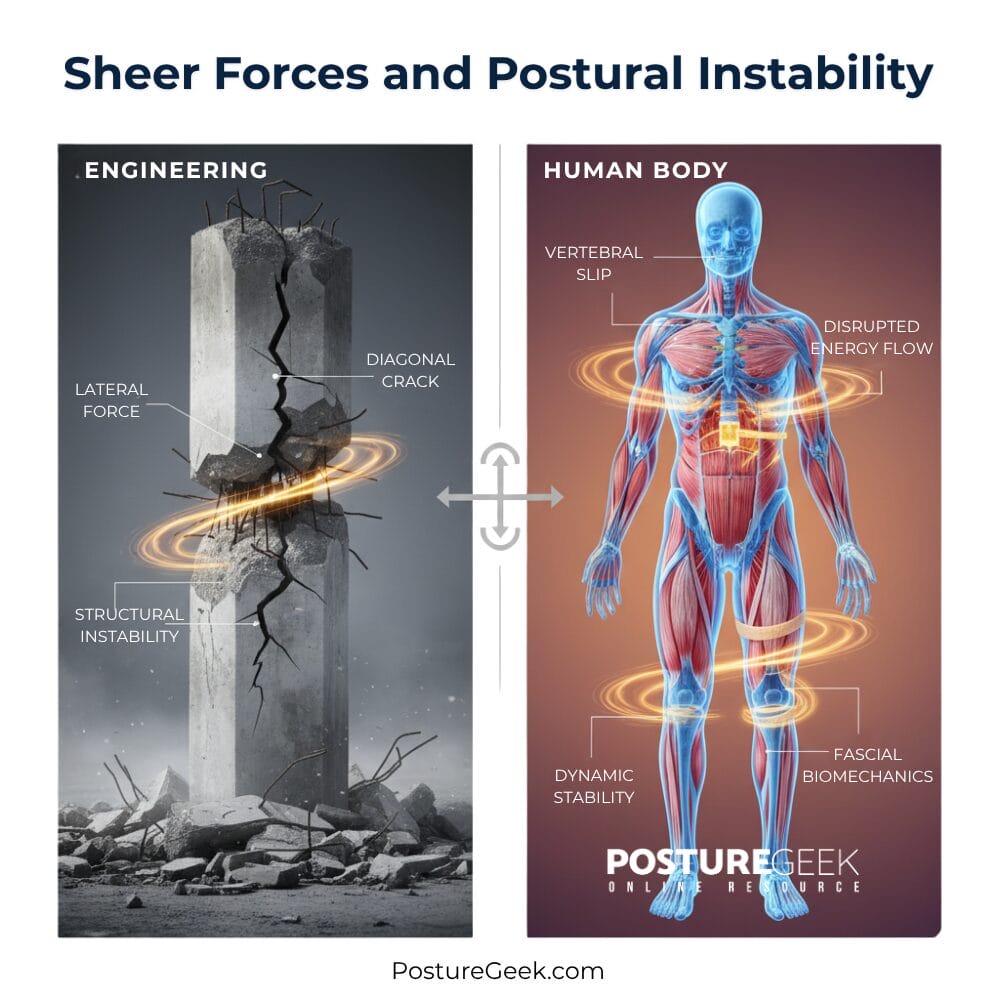
In Engineering
Shear failure occurs when one section of a column slides sideways against another. The force moves laterally instead of vertically, creating diagonal cracks that compromise stability. Once those internal bonds begin to slip, the structure can no longer resist gravity. What starts as a subtle shift often ends in rapid collapse.
In the Human Body
Shear in the body is less dramatic but no less significant. It appears when connected parts begin to move out of sync. A vertebra that glides forward on the one below it, a knee that rotates as the leg bears weight, or a shoulder blade that loses its smooth rhythm with the rib cage are all examples of shear in motion. These small disconnections interrupt the flow of force through the body. Instead of energy transferring upward and downward in harmony, it leaks sideways, illustrating how fascial biomechanics influence stability.
Over time, that energy loss becomes strain, inflammation, or instability. The body begins to work harder to achieve the same level of support, often recruiting muscles that were never meant to bear those loads.
The Living Difference
Unlike concrete, the body has options. It can sense, respond, and reorganize. Muscles, fascia, and ligaments serve as a living system of reinforcement, adjusting to new forces in real time. When coordination and timing are well trained, these tissues share load efficiently and keep the joints aligned even under pressure. When they are weak, fatigued, or poorly coordinated, lateral shear can turn into pain or injury.
This is where awareness and movement variety play their role. A body that learns to move in multiple directions, through strength and fluidity, develops resilience against shear. It stays adaptable, distributing forces rather than resisting them, and stability becomes something dynamic instead of rigid.
Fascial Reinforcement and the Architecture of Posture
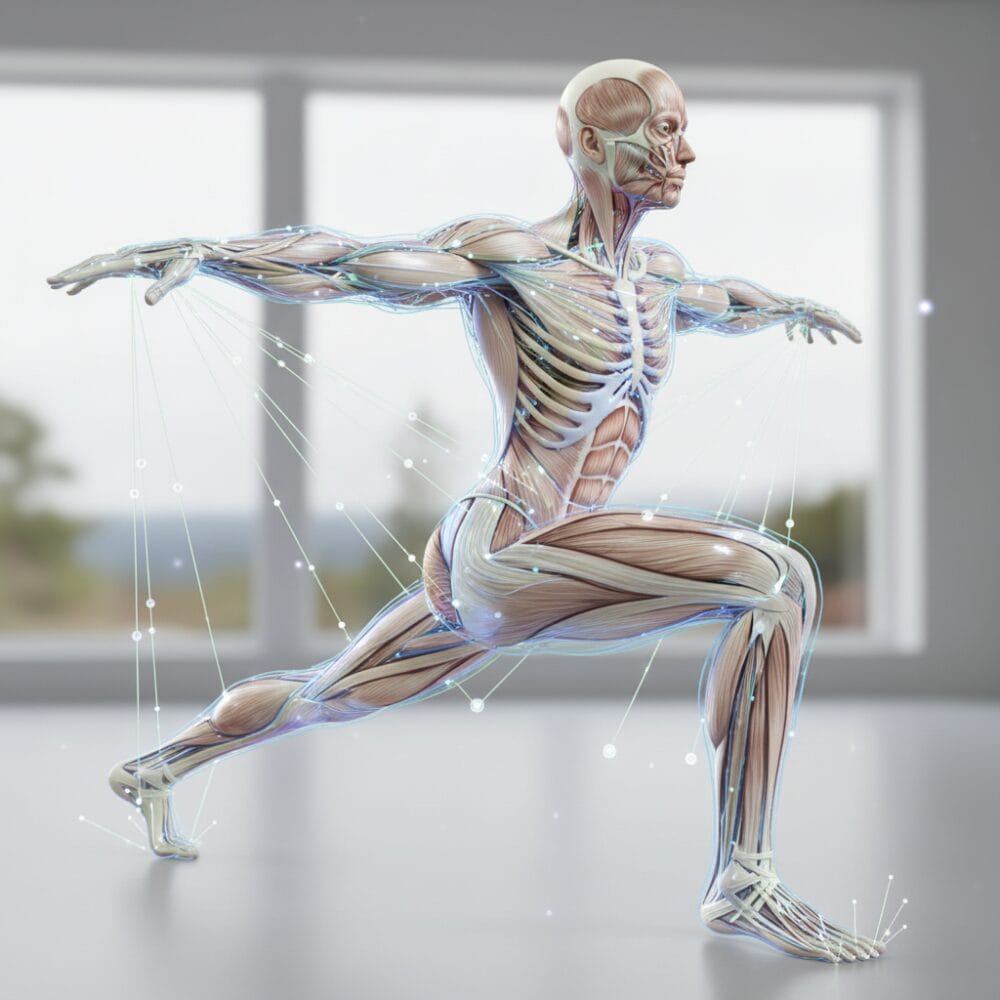
A Living Version of Rebar
Engineers strengthen columns with rebar to keep them from crumbling under load. The human body does something similar, but through living material. Fascia, ligaments, and tendons form a continuous tension network that links every bone and muscle into a single, responsive structure. This network balances compressive and tensile forces so the skeleton remains supported without rigidity.
The Principle of Tensegrity
This design is known as tensegrity, a concept shared by both architecture and anatomy. In a tensegrity system, bones act as struts that resist compression, while the fascia and connective tissues create tensile forces that hold everything in place. Together they create a self-sustaining equilibrium that is both stable and flexible. The result is movement without collapse, structure without stiffness, and a body capable of dynamic balance under constant load. This principle defines the balance of compression and tension within fascial biomechanics, the connective foundation of movement and posture.
An Intelligent Web of Communication
Fascia is not passive. It senses movement, tension, and vibration throughout the body, constantly sending information that guides how tissues contract, glide, and adapt. When one region tightens or weakens, the rest of the system compensates. A stiff ankle can change the mechanics of the knee and hip. A shoulder restriction can subtly alter the curve of the spine. Each adjustment helps maintain function in the short term, but long-term compensation shifts the body’s alignment and efficiency.
Adaptability Over Isolation
The body never isolates failure. It redistributes it. When tension patterns change, new ones emerge elsewhere to share the load. This is both a strength and a vulnerability. It allows us to keep moving despite strain, but it also hides imbalance until symptoms appear. Recognizing this pattern helps explain why local pain often begins far from its origin. The body operates as a connected system, not as separate parts, a key theme in modern movement mechanics.
Strength Through Connection
Viewing posture through the lens of fascia changes how we understand support. Posture is not a vertical stack of bones held together by muscle effort. It is a living architecture that finds stability through communication. Strength in this system comes not from rigidity but from the ability of every part to sense, respond, and share the work of alignment, the hallmark of efficient postural biomechanics.
Adaptation and the Biomechanics of Posture
A Structure That Learns
The most remarkable quality of the human body is its ability to adapt. A concrete column cannot sense, repair, or reshape itself to meet new demands. The body can. Every time we move, lift, or even sit, forces pass through bones, fascia, and muscle. These forces are not just resisted; they are interpreted. The body learns from them. It is a structure designed not only for support but for constant evolution.
The Dialogue Between Load and Response
Every load, stretch, and shift in position sends information through the nervous system and connective tissues. Muscles strengthen or weaken in response to demand. Fascia reorganizes and thickens along the lines of stress. Bones remodel to handle repeated load, creating the density and shape required for the forces they face. This ongoing process of feedback and adaptation protects us from the wear of daily life. It is the reason we can recover, rebuild, and grow stronger from physical stress instead of breaking down under it.
When Adaptation Turns Against Us
Adaptation is neutral. It responds to repetition without judgment. When we move efficiently, it strengthens good patterns. When we move poorly, it reinforces dysfunction. Hours of sitting, uneven loading, or repetitive movement teach the body to make those positions easier to maintain. Over time, poor posture becomes familiar, and familiar becomes efficient. The body adapts beautifully, but not always in our favor. What began as protection can quietly become limitation. A pattern well recognized in structural alignment and movement mechanics.
A Living Conversation
The biomechanics of posture are not fixed; they are in constant dialogue. Every movement is part of an ongoing conversation between load and response, between gravity and awareness. When we change how we move, we change what the body learns to support. This is why mindful variation in movement is essential. It keeps the conversation alive, allowing tissues to stay supple, joints to stay responsive, and the whole structure to remain adaptable within the biomechanics of posture.
The Purpose of Awareness
Awareness is the bridge between passive adaptation and intentional change. The moment we notice how we stand, breathe, or carry weight, we interrupt the cycle of unconscious repetition. That small shift begins to retrain the system. Adaptation is always happening. Awareness decides the direction it takes.
Lessons from Load and Gravity
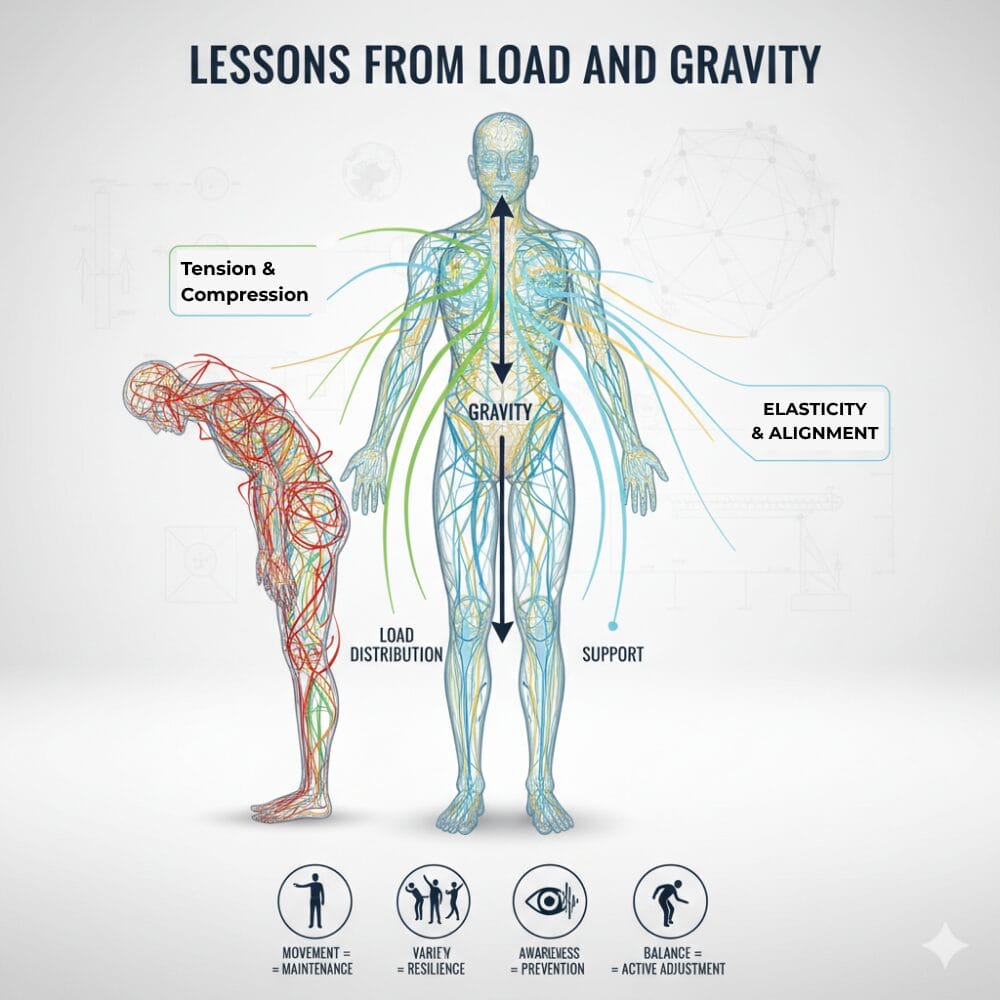
The Constant of Gravity
Gravity never changes, yet our response to it does. Every time we move, sit, or stand, the body must negotiate with this unrelenting force. Gravity is both the source of our structure and the challenge that shapes it. Whether we experience strength or strain depends on how effectively we share that load through the body.
A Dynamic Relationship
The human body is not designed to resist gravity passively but to work with it. Our posture, movement patterns, and breathing all influence how that force travels through us. When alignment and support are well organized, gravity becomes a stabilizing partner. When tension patterns dominate, it turns into compression and fatigue. The way we distribute load determines whether gravity grounds us or wears us down.
Key Reminders
- Movement is maintenance
Movement keeps the structure alive. Just as an engineer checks for small cracks before they spread, regular and varied motion maintains the integrity of the system. Stillness invites stiffness; motion preserves elasticity and awareness.
- Variety builds resilience
The body thrives on variation. Changing position, moving through full range, and building strength in different planes promote balanced load distribution. Diversity of movement keeps the fascial web responsive and prevents overuse patterns from taking hold.
- Awareness prevents collapse
Posture begins in perception. Paying attention to small shifts in how we stand, sit, or move allows early correction before tension accumulates. Awareness is the first form of structural repair.
- Balance is active, not fixed
A column can stand motionless, but a human cannot. We balance through constant adjustment. Micro-movements in the feet, hips, and spine keep us upright and responsive. True balance is not about holding still; it is about continuous, intelligent motion.
Working With, Not Against, Gravity
The lesson is simple but powerful. Gravity will always be present, yet how we meet it determines whether it becomes our adversary or our ally. Through movement, variation, and awareness, we turn gravity into the force that teaches alignment, not the one that erodes it.
The Living Column
A Structure in Motion
The human body is not a rigid column built to defy gravity, but a living structure that collaborates with it. Each step, breath, and shift in balance is part of an ongoing dialogue between support and surrender. The body finds strength not in resisting gravity but in reorganizing around it. This constant, subtle movement is what keeps us upright, responsive, and alive to our environment.
Adaptation as Intelligence
Where concrete relies on design, the body relies on awareness. Every adjustment in posture or movement is an expression of biological intelligence. Muscles engage, fascia tensions adjust, and bones realign in response to demand. This adaptability is not random—it is the body’s way of preserving coherence within change. The living column learns. It strengthens where pressure is needed and softens where motion must return.
From Mechanics to Meaning
Understanding posture through the lens of mechanics reveals more than physics. It shows the balance between rigidity and adaptability that mirrors how we live. Too much stiffness, and we fracture. Too much softness, and we lose form. Healthy posture exists in the space between—where awareness guides tension, and gravity becomes a teacher rather than a threat.
The Takeaway
Every movement we make is an act of engineering, an experiment in equilibrium. When we learn to sense how load moves through the body, we begin to influence it consciously. Gravity never stops pressing down, yet we never stop rising to meet it. That is the true architecture of posture: not fixed, not perfect, but continually renewed through awareness and adaptation.
Continue Learning
At PostureGeek, we explore the biomechanics of posture through education designed for both practitioners and curious learners.
If you would like to understand how structure, load, and adaptation come together in the human body, visit our Courses & Learning Hub to explore the growing range of programs.
PLEASE NOTE
PostureGeek.com does not provide medical advice. This information is for educational purposes only and is not intended to be a substitute for professional medical attention. The information provided should not replace the advice and expertise of an accredited health care provider. Any inquiry into your care and any potential impact on your health and wellbeing should be directed to your health care provider. All information is for educational purposes only and is not intended to be a substitute for professional medical care or treatment.
About the author
Join our conversation online and stay updated with our latest articles.
Find Expert Posture Practitioner Near You
Discover our Posture Focused Practitioner Directory, tailored to connect you with local experts committed to Improving Balance, Reducing Pain, and Enhancing Mobility.
